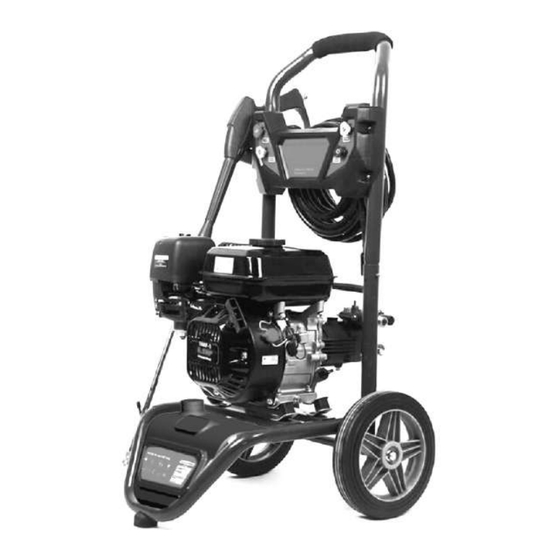
Bison 130 Owner's Manual
Gasoline high pressure washer
Hide thumbs
Also See for 130:
- Owner's manual (15 pages) ,
- Instruction manual (15 pages) ,
- Owner's manual (16 pages)
Summary of Contents for Bison 130
- Page 1 GASOLINE HIGH PRESSURE WASHER OWNERS MANUAL CAUTION Read the instructions before using the machine.
-
Page 2: General Safety Instructions
GENERAL SAFETY INSTRUCTIONS ■ Read instructions carefully before operating this product. ■ Keep bystanders away. ■ This product is for outdoor use only. ■ Ensure the engine is stopped before carrying out adjustments, cleaning or maintenance. ■ Always turn off the engine and water supply when finished. ■... -
Page 3: Maintenance And Storage
MAINTENANCE AND STORAGE ■ Do not attempt to modify the product in any way. ■ To ensure good operating condition arrange regular servicing from an authorising agent. ■ Only use replacement parts supplied by the manufacturer ■ Only use fresh,clean and good quality fuel in the engine. ■... - Page 4 ASSEMBLY NOTE: Every machine is tested during production, so there may a few drops of water inside the pump assembly. FIG. 1 FIG. 2 TO ASSEMBLE THE WHEELS (Figs. 1-2): Assemble the wheel on the axle Insert the axle into the axle tube at and fix it with a nut.
-
Page 5: Operation And Use
PUMP (FIG9): If you buy a machine without a red breathing plug, please ignore FIG8 OPERATION AND USE WARNING: The engine is not filled with oil. It is necessary to fill the unit before starting the engine. The engine will not produce a spark unless sufficient oil is inside. CAUTION: Do not run the engine with high or low oil level as this can cause engine damage. - Page 6 WATER SUPPLY FROM THE WATER MAIN ■Connect a water supply hose (not supplied) to the water inlet connection of the pressure washer. ■Machine not suitable for connection to the potable water mains ■Turn on the water supply and pull the trigger until water is continually flowing out of the nozzle.
- Page 7 FIG. 19 FIG. 20 FIG. 21 Pull the black starting rope Let the engine idle for a short When the appliance is in handle gradually until you while to preheat before pushing operation the speed can be feel resistance; then make a the choke lever C to the right.
- Page 8 NOTE: Before using the pressure washer to clean patio paving slabs it is advisable to test a small area first, some paving slabs are manufactured from inferior materials and the use of a pressure washer could damage the surface. USING THE DETERGENT FACILITY (Fig. 25) Fill a suitable container with pressure water detergent.
-
Page 9: Pre-Operation Inspection
12.High-pressure jets can be dangerous if misused. Do not aim at people, animals, active electrical equipment or at the appliance itself . Wear safety shoes! Wear safety goggles! Wear protective gloves! Forbidden to adjust Forbidden to adjust pressure valve, Otherwise it will cause pump damage。 pressure valve Thermal relief valve... -
Page 10: Fuel And Fuel Tank
FUEL AND FUEL TANK: Only use unleaded petrol or fuel with an octane number over 86. Using unleaded petrol or fuel will decrease the possibility of producing carbon deposit and prolong the engines service life. Never use old or polluted petrol or fuel or a mixture of petrol and engine oil. -
Page 11: Maintenance
MAINTENANCE EXHAUST CONTROL SYSTEM With the engine running, carbon monoxide, nitrogen oxide and hydrocarbon are produced, and in certain conditions nitrogen oxide and hydrocarbon will react together to make smoke while carbon monoxide is toxic, so exhaust control is very important. The manufacturer decreases exhaust emissions by introducing poor-fuel carburettors and other devices to solve the problem. -
Page 12: Prepare For Storage
TRANSPORT Transport with the fuel switch in the off position. Ensure the engine is cooled so as to avoid the risk of burns or fire. CAUTION: Do not tilt the engine to avoid spilling fuel. Spilled fuel or fuel vapour may ignite. STORAGE If the engine is not to be used for a long period of time ensure it is stored correctly. -
Page 13: Engine Oil Replacement
To keep the engine in sound condition, the user should maintain it according to the table below. CAUTION: Use parts that are supplied by the manufacturer, otherwise damage to the engine may occur. WARNING: Stop the engine before servicing. If servicing is required with the engine running ensure there is good ventilation in the area. -
Page 14: Pump Troubleshooting
TROUBLESHOOTING PUMP TROUBLESHOOTING TROUBLE PROBABLE CAUSE REMEDY Pump sucking in air Check connection are tight Fluctuating pressure Valves dirty, worn out or seized Contact customer helpline Remove blockage using jet cleaning tool Blocked jet Contact customer helpline Water leakage from pump Seals worn out Check tightness of all connections Pump sucking in air from... - Page 15 -14-...







Need help?
Do you have a question about the 130 and is the answer not in the manual?
Questions and answers